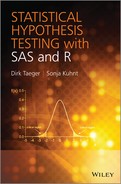Chapter 10
Other Tests
In this chapter we present a well-known test for the problem if two independent samples are drawn from the same population or not. The test is based on very few assumptions, for example, it is not necessary to specify the distributions beyond the fact that they are continuous distributions.
10.1 Two-sample tests
10.1.1 Kolmogorov–Smirnov two-sample test (Smirnov test)
| Description: | Tests if two independent samples are sampled from the same distribution. |
| Assumptions: |
|
| Hypotheses: | (A) |
| (B) |
|
| (C) |
|
| Test statistic: | (A) |
| (B) |
|
| (C) |
|
| where |
| Test decision: | Reject |
| (A) |
|
| (B) |
|
| (C) |
|
| The critical values |
|
| p-values: | (A) |
| (B) |
|
| (C) |
|
| Annotations: |
|
Example
To test the hypothesis that the two populations of healthy subjects (status=0) and subjects with hypertension (status=1) do not differ with respect to the distribution of their systolic blood pressure. The dataset contains  observations for status=0 and
observations for status=0 and  observations for status=1 (dataset in Table A.1).
observations for status=1 (dataset in Table A.1).
SAS code
proc npar1way data=blood_pressure D; class status; var mmhg; exact edf; run;
SAS output
The NPAR1WAY Procedure
Kolmogorov–Smirnov Test for Variable mmhg
Classified by Variable status
EDF at Deviation from Mean
status N Maximum at Maximum
---------------------------------------------------
0 25 0.880000 2.218182
1 30 0.066667 -2.024914
Total 55 0.436364
Maximum Deviation Occurred at Observation 25
Value of mmhg at Maximum = 125.0
KS 0.4050 KSa 3.0034
Kolmogorov–Smirnov Two-Sample Test (Asymptotic)
D = max |F1 - F2| 0.8133
Pr > D <.0001
D+ = max (F1 - F2) 0.8133
Pr > D+ <.0001
D- = max (F2 - F1) 0.0000
Pr > D- 1.0000
Remarks:
- The option D enables the one-sided (B) and (C) tests in addition to the two-sided test (A). However, if only the two-sided test is desired, do not use any option or the option EDF.
- exact edf is optional and applies an additional exact test. Note, the computation of an exact test can be very time consuming. Although this option is given in the listing, the output is generated without this option because it would have taken too much time to calculate the exact p-values even for this tiny dataset.
 is the test statistic for hypothesis (B) and
is the test statistic for hypothesis (B) and  is the test statistic for hypothesis (C). From Figure 10.1 it can be seen that the cumulative distribution function of the healthy subjects is above the cumulative distribution function of the subjects with hypertension. Accordingly hypothesis (B) is rejected while hypothesis (C) is not.
is the test statistic for hypothesis (C). From Figure 10.1 it can be seen that the cumulative distribution function of the healthy subjects is above the cumulative distribution function of the subjects with hypertension. Accordingly hypothesis (B) is rejected while hypothesis (C) is not.
R code
x<-blood_pressure$mmhg[blood_pressure$status==0] y<-blood_pressure$mmhg[blood_pressure$status==1] ks.test(x,y,alternative="two.sided",exact=FALSE)
R output
Two-sample Kolmogorov–Smirnov test data: x and y D = 0.8133, p-value = 2.923e-08 alternative hypothesis: two-sided
Remarks:
- alternative=“value” is optional and defines the type of alternative hypothesis: “two.sided”= the cumulative distribution functions of
 and
and  do not differ (A); “greater”= the cumulative distribution function of
do not differ (A); “greater”= the cumulative distribution function of  lies above
lies above  (C); “less”=the cumulative distribution function of
(C); “less”=the cumulative distribution function of  lies below
lies below  (B). Default is “two.sided”.
(B). Default is “two.sided”. - exact=value is optional. If value is not specified or TRUE an exact p-value is computed if the product of the sample sizes is less than 10 000, otherwise only the approximative p-value is computed. In the case of ties or a one-sided alternative no exact test is computed.
 is the test statistic for hypothesis (B) with option alternative=“greater” and
is the test statistic for hypothesis (B) with option alternative=“greater” and  is the test statistic for hypothesis (C) with option alternative=“less”. From Figure 10.1 it can be seen that the cumulative distribution function of the healthy subjects is above the cumulative distribution function of the subjects with hypertension. Accordingly hypothesis (B) is rejected while hypothesis (C) is not.
is the test statistic for hypothesis (C) with option alternative=“less”. From Figure 10.1 it can be seen that the cumulative distribution function of the healthy subjects is above the cumulative distribution function of the subjects with hypertension. Accordingly hypothesis (B) is rejected while hypothesis (C) is not.
Figure 10.1 Cumulative empirical distribution functions of the blood pressure of healthy subjects (bold lines) and subjects with hypertension (non-bold lines).

References
Sheskin D. 2007 Handbook of Parametric and Nonparametric Statistical Procedures, 4nd edn. Chapman & Hall.
Steck G.P. 1969 The Smirnov two sample tests as rank tests. The Annals of Mathematical Statistics 40, 1449–1466.
..................Content has been hidden....................
You can't read the all page of ebook, please click here login for view all page.
